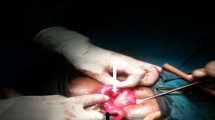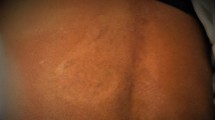Abstract
Background
A pyosalpinx is the acute inflammation of the fallopian tube, which fills up and swells with pus. It commonly results from inadequate or delayed treatment of pelvic inflammatory disease.
Case presentation
We report the case of a 54-year-old Africain female patient, who presented with sustained high-grade fever, right flank pain, and severe acute storage low-urinary-tract symptoms. Computed tomography showed signs of acute obstructive pyelonephritis with a right tubular juxtauterine mass with complex internal fluid and thick enhancing walls exerting a mass effect on the right ureter. A drainage of the right excretory cavities by a JJ stent was performed. An ultrasound-guided aspiration of the collection was also performed.
Conclusion
A pyosalpinx can then exert a mass effect on the excretory cavities, thus causing an acute obstructive pyelonephritis. A double drainage coupled with an effective antibiotic therapy is then necessary.
Similar content being viewed by others
Case presentation
A 56-year-old menopausal multiparous Africain female with well-controlled hypertension and type 2 diabetes mellitus, presented to the emergency department for sustained high-grade fever, right flank pain, and severe low-urinary-tract symptoms (LUTS). On physical examination, she was in mild distress due to pain. Triage vitals showed a blood pressure of 100/56 mmHg, a heart rate of 120 beats per minute, a temperature of 39.4 °C, a respiratory rate of 22 breaths per minute, and an oxygen saturation status of 95% in room air. An abdominal examination revealed a soft abdomen with mild diffuse generalized abdominal tenderness and right renal angle tenderness; however, no guarding or rigidity was observed. All other physical examinations, including the central nervous system examination, were normal. Blood work revealed a white blood cell count of 18.7 × 103/dl, a mild anemia, and a creatinine level of 7 mg/l; C-reactive protein (CRP) level was 294.6 mg/l. Urinalysis showed combined hematuria and pyuria with the urine culture demonstrating the growth of > 105 E. coli. Then patient underwent a contrast-enhanced computed tomography (CT) of the abdomen and pelvis. CT showed a right hydroureteronephrosis, infiltration of the right perirenal fat, and multiple nephritis foci (Fig. 1). In addition, CT findings include a right tubular juxtauterine mass with complex internal fluid and thick enhancing walls (Fig. 2), exerting a mass effect on the right ureter (Fig. 3). Ultrasound showed an irregular adnexal cystic mass with a thickened wall, measuring 6 cm. The “cogwheel sign” suggested that the mass was a pyosalpinx (Fig. 4). Testing for Chlamydia trachomatis, Neisseria gonorrhoeae, reactive plasmin reagin, and human immunodeficiency virus was negative. She was started on a combination of ceftriaxone, metronidazole, and doxycycline along with paracetamol. A ureteric stent was placed. An ultrasound probe was placed transvaginally. An 18-gauge needle was advanced into the collection, and 50 ml of fluid was aspirated. The material was partially complex and partially simple in character. The fluid collection collapsed entirely, and the needle was removed. The culture was polymicrobic. It was negative for Chlamydia trachomatis and Neisseria gonorrhoeae. Tuberculosis was also ruled out on further workup. She was discharged after 3 days, on oral amoxicillin for 10 days. At 2 month follow-up, she was fine and asymptomatic.
Discussion
Suspicion of upper genital infection is a frequent clinical situation in gynecological emergencies and in primary care consultations. Pyosalpinx and tubo-ovarian abscess are almost always complications of pelvic inflammatory disease and are sexually transmitted infections in several cases. Pyosalpinx is defined as purulent intratubal collections, which may occur de novo or by ascending infection of a hydrosalpinx. Therefore, pyosalpinx and tubo-ovarian abscess are usually observed in young women; they are rarely found in older women [3]. In the literature, 194 cases of pyosalpinx or tubo-ovarian abscess in postmenopausal woman have been reported [3, 4]. Pyosalpinx may present with very few specific symptoms or remain silent [5]. Less than 50% of women with pyosalpinx present with fever and chills [5, 6]. Other symptoms include nausea, vaginal discharge, and abnormal vaginal bleeding [5, 6]. Functional urinary signs are reported in 15–30% of upper genital infections [7]. On physical examination, patients may show tenderness over the adnexal region with or without guarding or rebound. The absence of specific symptoms and conclusive signs during the physical examination may delay a proper diagnosis [5]. In the majority of cases, salpingitis results from a sexually transmitted ascending infection [2]. In sexually inactive females, biological factors may play a role in the development of infection, including decreased level of protective antibodies, relative larger zone of cervical ectopy, greater permeability of cervical mucus, and alteration of vagina flora [2]. The initial imaging modality of choice for the diagnosis of pyosalpinx is transvaginal ultrasound, because it is cost-effective and allows detailed visualization of pelvic structures. Ultrasound can show a dilated serpentine/tubular structure in the pelvis. Low-level echoes due to the higher protein content of the debris within the tube distinguish a pyosalpinx from a hydrosalpinx. Abdominopelvic computed tomography with contrast injection is often performed in an emergency setting. Typically, the pyosalpinx forms an elongated pseudocystic image, latero-uterine and then curving backwards from the uterus towards the cul-de-sac of Douglas, marked by one or more flexion folds. The wall and folds appear thick and echogenic. The 3D mode allows a more precise analysis of the shape and partitions. Under the probe, particularly vaginally, the mass is fixed and painful. Magnetic resonance imaging is a very useful method to examine and diagnose gynecological organs in elderly as well as young women. Magnetic resonance imaging images in the pelvis show a markedly dilated fallopian tube posterior to the ovary, edema surrounding the fallopian tube, and a thickened and enhanced tube wall with active inflammation. The early diagnosis of this pathology is hampered by its rarity and overlapping of symptoms with other causes of the acute abdomen, such as acute appendicitis, cystitis, gastroenteritis, pyelonephritis, and peritonitis [1, 2]. As a therapy for pyosalpinx, it is recommended that antibiotics therapy is started as soon as possible for patients [4, 8]. Pyosalpinx requires prompt diagnosis, admission, intravenous antibiotics, and possibly aspiration or surgery [5, 9]. Treatment of pyosalpinx varies from conservative management with intravenous antibiotics to laparoscopic aspiration, image-guided aspiration or drainage, laparoscopic salpingostomy, or salpingectomy [5, 10]. In more than 75% of patients, antibiotics alone may be sufficient for treating pyosalpinx [11]. In case of a collection > 3–4 cm, drainage should be performed because the failure rate is higher in the absence of drainage as is the risk of serious complications [12].
Conclusion
Pyosalpinx is a less severe form of pelvic inflammatory disease that leads to shorter hospital stays and more favorable outcomes than tubo-ovarian abscess. Pyosalpinx unrelated to sexually transmitted infection is rare but should be considered in non-sexually active women. Imaging modalities such as ultrasound and computed tomography can aid in making the diagnosis of pyosalpinx. Early pyosalpinx can be treated successfully with adequate antibiotic coverage. Pyosalpinx when associated with an adjacent abscess usually requires percutaneous or surgical intervention.
Availability of data and materials
The datasets are available from the corresponding author on reasonable request.
References
Moralioglu S, Ozen IQ, Demirogullari B, Basaklar AC. Pyosalpinx and hydrosalpinx in virginal adolescents: report of two cases. W Indian Med J. 2013;62(3):257.
Afzal M, Kothari M, Alghasham A, Attal M. Isolated pyosalpinx in a pre-teen with bicornuate uterus. J Pediatr Surg Case Rep. 2021;72: 101977.
Hira S, Ikeda E, Kamijo K, Nagai T, Tsunemi K, Uchiyama N, et al. Pyosalpinx due to Cronobacter sakazakii in an elderly woman. BMC Women’s Health. 2021;21(1):136.
Hida M, Anno T, Kawasaki F, Kaneto H, Kaku K, Okimoto N. A rare case of large pyosalpinx in an elderly patient with well-controlled type 2 diabetes mellitus: a case report. J Med Case Rep. 2018;12:286.
Sendy S, Abuy A, Sendy W, Baradwan S. Unusual presentation of bilateral pyosalpinx mimicking an ovarian torsion: a case report. Ann Med Surg (Lond). 2020;52:16–8.
Velcani A, Conklin P, Specht N. Sonographic features of tubo-ovarian abscess mimicking an endometrioma and review of cystic adnexal masses. J Radiol Case Rep. 2010;4:9–17.
Charveriat A, Fritel X. Diagnostic d’une infection génitale haute : critères cliniques, paracliniques, imagerie, et cœlioscopie. RPC infections génitales hautes CNGOF et SPILF. Gynecol Obstet Fertil Senol. 2019;47:404–8.
Orkowski KA, Bolan GA. Centers for disease control and prevention. Sexually transmitted diseases treatment guidelines, 2015. MMWR Recomm Rep. 2015;64:1–137.
Adhikari S, Blaivas M, Lyon M. Role of bedside transvaginal ultrasonography in the diagnosis of tubo-ovarian abscess in the emergency department. Emerg Med. 2008;34(4):429–33.
Agbor VN, Njim T, Aminde LN. Pyosalpinx causing acute appendicitis in a 32-year-old Cameroonian female: a case report. BMC Res. 2016;9:368.
Maraqa T, Mohamed M, Coffey D, Sachwani-Daswani GR, Alvarez C, Mercer L. Bilateral recurrent pyosalpinx in a sexually inactive 12-year-old girl secondary to rare variant of Müllerian duct anomaly. BMJ Case Rep. 2017;2017:bcr2016218924.
Graesslin O, Verdon R, Raimond E, Koskas M, Garbin O. Prise en charge des abcès tubo-ovariens (ATO) et des formes compliquées d’infections génitales hautes. RPC infections génitales hautes CNGOF et SPILF. Gynecol Obstet Fertil Senol. 2019;47(5):431–41.
Acknowledgements
Authors wish to thank all the teams of the urology department of the La Rabta University Hospital for their efforts.
Funding
No funding was received.
Author information
Authors and Affiliations
Contributions
Study concept: KC, MT, YO, and EA. Writing the paper: KC, AM, BM, and WE. Data interpretation: KMD, OC, MB, AA, and YN. All authors read and approved the final manuscript.
Corresponding author
Ethics declarations
Ethical approval and consent to participate
The institution (La RABTA University Hospital) exempts the case report from ethical approval. Written informed consent was obtained from the patient for publication of this case report and accompanying images.
Informed consent
Written informed consent was obtained from the patient for publication of this case report and any accompanying images. A copy of the written consent is available for review by the Editor-in-Chief of this journal.
Competing interests
The authors declare that there is no conflict of interest.
Additional information
Publisher’s Note
Springer Nature remains neutral with regard to jurisdictional claims in published maps and institutional affiliations.
Rights and permissions
Open Access This article is licensed under a Creative Commons Attribution 4.0 International License, which permits use, sharing, adaptation, distribution and reproduction in any medium or format, as long as you give appropriate credit to the original author(s) and the source, provide a link to the Creative Commons licence, and indicate if changes were made. The images or other third party material in this article are included in the article's Creative Commons licence, unless indicated otherwise in a credit line to the material. If material is not included in the article's Creative Commons licence and your intended use is not permitted by statutory regulation or exceeds the permitted use, you will need to obtain permission directly from the copyright holder. To view a copy of this licence, visit http://creativecommons.org/licenses/by/4.0/. The Creative Commons Public Domain Dedication waiver (http://creativecommons.org/publicdomain/zero/1.0/) applies to the data made available in this article, unless otherwise stated in a credit line to the data.
About this article
Cite this article
Chaker, K., Ouanes, Y., Azouz, E. et al. Acute obstructive pyelonephritis due to pyosalpinx: a case report. J Med Case Reports 17, 166 (2023). https://doi.org/10.1186/s13256-023-03900-6
Received:
Accepted:
Published:
DOI: https://doi.org/10.1186/s13256-023-03900-6








